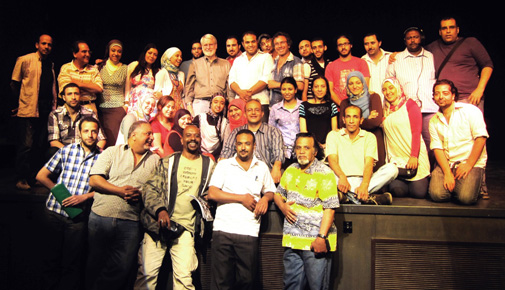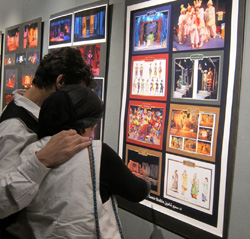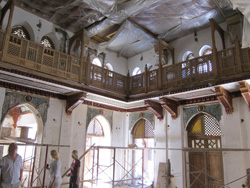News & Notices
Egypt Hosts First OISTAT Meeting

Cairo Lighting Design Workshop with Michael Ramsaur
Images/Courtesy of Michael Ramsaur
OISTAT held an Executive Committee meeting in Cairo Egypt from May 4 to 8. This was an important occasion since Egypt is a new OISTAT Center, and this was the first meeting it has hosted. The OISTAT group consisted of seven of the eight member Executive Committee.
As with most OISTAT meetings, this meeting was a combination of the EC addressing the various business elements of the organization (membership, finances, future schedules, major projects), attending presentations from the host OISTAT Center, and the international guests giving presentations to the local theatre community.

ESTTC first scenography exhibition for theatre designers
Hazem Shebl, president of ESTTC, hosted the event. He has attended many USITT Annual Conferences. There was a presentation about the history of scenic design in Egypt which spans the opening of Cairo’s Khedivial Opera in 1871 with Queen Ogeny attending, fittingly enough, the premier production of the opera Aida. The first education for stage design in Egypt was offered in 1955. Egyptian colleagues outlined three generations of Egyptian stage designers who cited peer learning, external travel, and international guests as important for developing design sensibility.
The Egyptian OISTAT Center, ESTTC, held its first scenography exhibition for theatre designers, which displayed designs from over 45 Egyptian scenic, costume, lighting, and sound designers. The international guests were present at the opening ceremony and reception and had ample opportunity to discuss design and practical issues with their Egyptian colleagues.
OISTAT EC members gave presentations on LED technology, lighting design techniques for musical theatre, scenic construction methods, ritual theatre, theatre architecture, and technical theatre training. There was particular interest by the Egyptian colleagues for the rather unique technical theatre training program established in Sweden presented by Richart Bauer. TTTS began as an informal arrangement between technical leaders from theatres in Sweden to provide what they saw as needed technical training. This program has developed into an extremely successful series of continuing education gatherings taught by the members of the theatre technical staff and guests. These workshops have greatly improved technical knowledge as well as encouraged better collaboration among the technical, design, and administrative staffs.

National Theatre Lobby under reconstruction
As part of its administrative business, three very active international projects were discussed. The World Scenography 1975-1990 publication was recently published and was available at the USITT 2012 Annual Conference & Stage Expo. It was acknowledged that the book is a very important addition to knowledge about world views of Scenography. The book is available for purchase at www.worldscenography.org.
Digital Theatre Words, a project to translate and describe over 2,000 theatre design and technical words, is now online with 18 languages (and growing). The address will soon be changed to dtw.usitt.org. DTW will be seeking advertisers who wish their companies to be seen when users are searching for terms in their language.
World Stage Design Exhibit of theatrical design will be held in Cardiff Wales between September 5 and 15. Any designer can submit work to be exhibited. All work submitted will be exhibited via digital projection, and a jury will select 100 designs to be exhibited physically. There will be a Scenofest as part of World Stage Design. Many lecturers, workshops, and performances are planned. Schools or young companies can apply via the website to present performances as part of Scenofest. Information about WSD'13 is available at www.wsd2013.org.
During the visit to Cairo, meeting attendees were able to tour and attend a performance at the Cairo Opera House and to visit the National Theatre which is under reconstruction. There was also time to visit the pyramids and Sphinx located just outside Cairo, as well as experience local cafes.
Michael Ramsaur presented a one-day Lighting Design Workshop to about 30 members of ESTTC and other interested designers and directors. The group was extremely receptive to the work presented and to the student work.

